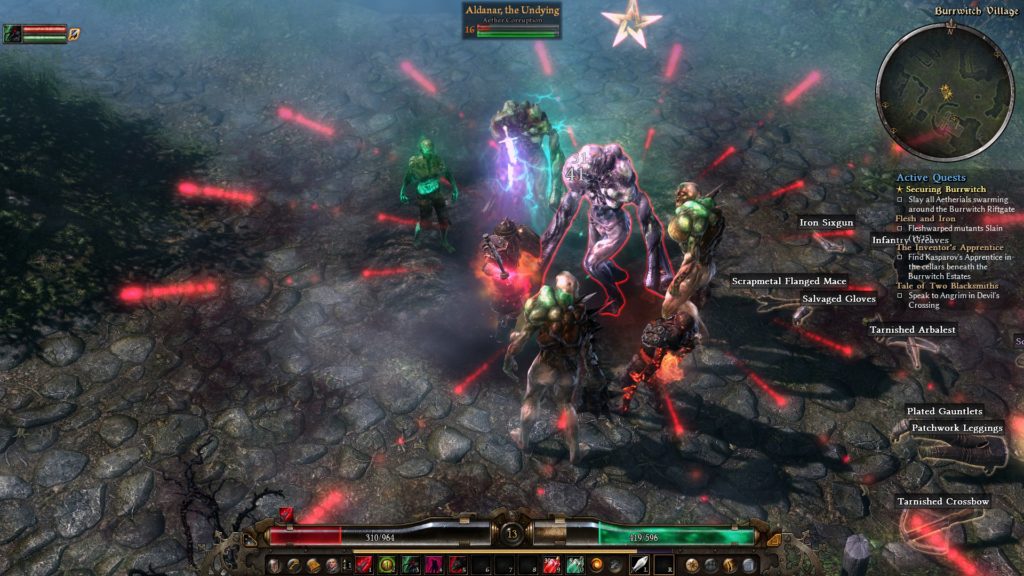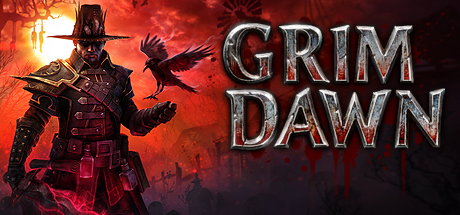 In an age of instant gratification and overly streamlined character progression, ARPGs are at something of a crossroads. Some are designed so that the player is always only mere moments away from the next interesting loot drop while not-so-subtlety informing them of what they should be equipping, and others adopt the more nostalgic style of viable character build freedom at the cost of requiring the player to rub some neurons together.
In an age of instant gratification and overly streamlined character progression, ARPGs are at something of a crossroads. Some are designed so that the player is always only mere moments away from the next interesting loot drop while not-so-subtlety informing them of what they should be equipping, and others adopt the more nostalgic style of viable character build freedom at the cost of requiring the player to rub some neurons together.
Grim Dawn is an ode to the ARPGs of yesteryear, summoning the spirits of Diablo II and Titan Quest and melding them into an enjoyable, old-school hack ‘n slash with a few modern twists.
You begin the game as a recently possessed nobody fresh off the hangman’s noose, set loose in an apocalyptic, low fantasy setting where spirits from another plane of reality have royally mucked up your world. In the ensuing chaos, all manner of other horrors have slithered out from the shadows and set up shop. There isn’t much left worth saving, survival is all humanity can fight for now.
Grim Dawn sets a fantastically atmospheric stage that isn’t afraid to use gore and other horror elements in order to illustrate how far civilization has fallen. Mutilated corpses and piles of bone are frequent sights, a powerful blood cult leaves its victims strung up and drained of their fluids, amalgamations of decaying flesh lumber across burial grounds, and, in the darkest corners, literal oceans of blood and shorelines of skulls can be found. Grim Dawn doesn’t do cute.
Strangely, this is also what brings to light one of the games biggest failings. It is likely the result of low budget, but there is very little cinematic flair to be found in Grim Dawn. In fact, the only cutscene in the entire game is at the very beginning. The majority of the dialogue is unvoiced text and major plot points tend to lack gravitas since boss encounters have little to no introduction, speech, or dramatic conclusion. It doesn’t take much to imagine how much better the overall “feel” of the game would be with just a little more cinematic polish.
Whatever its shortcomings, Grim Dawn more than makes up for them with its meaty loot system and the freedom to experiment with many viable character builds.
Like Titan Quest, players are given the option to dual spec into two classes, creating a hybrid playstyle. It’s also perfectly fine and effective to choose to invest everything into one class. Even playstyles within one class can be significantly different depending on which skills the player chooses to focus on, and Grim Dawn does its best to accommodate players with appropriate loot options, regardless of which classes they pick.
Over the course of your battles, you’ll come across a wide variety of items called components. These can be anything from parts of creatures, old bits of armor, or pieces of ancient artifacts. Collecting these and merging duplicates into “complete” components unlocks powerful stat boosts and sometimes even new skills to slot into your gear.
Components can also be used to craft stronger, more specialized components, rare items, or unique relics that have their own gear slot and offer even more bonuses and skills. The most powerful craftables require the player to find and learn crafting plans before being able to make them, some of them only beginning to drop after reaching sufficiently high levels.
To further specialize your character, “epic” items will rarely drop that are handcrafted to benefit all sorts of different builds by increasing relevant skills or even providing new ones. After level 50, exceptionally powerful “legendary” tier items being to drop, although very rarely. Both epics and legendaries have item sets that can be collected and completing these sets bestow some of the most powerful bonuses in the game.
It won’t be an easy road though. Unlike Diablo III, Grim Dawn does not have a “smart loot” system that only drops items your character can use. You will frequently find items that might be effective for alternate character builds, tempting you to play with new classes. Personally, I prefer the omission of a smart loot system as it makes finding items that you’re looking for that much more exciting, but I understand that those who are short on time might not appreciate the large investment that is often required.
This sort of blind loot system still works thanks to the extremely flexible character system. Even without top of the line gear, players can still have an effective setup if they’re paying attention to what they’re doing. High level items are not always better than low level ones. High stat rolls on an item frequently beat out level.
If, for some reason, you felt like you needed even more character build options, Grim Dawn also includes a “devotion” system where players can seek out hidden shrines and restore them either through combat or offering items in order to earn points that can be spent towards honoring the gods and empowering their constellations. Doing so earns even more stat bonuses as well as special skills that augment existing skills with new effects that level up over time.
To find all these shrines, players will have to search every nook and cranny of the game world. Grim Dawn forgoes procedural generation in favor of handcrafted, persistent maps and this allows them to hide a surprising amount of secret areas within their game, ranging from small treasure troves to entirely new zones. Many shrines can only be found in higher difficulties, giving further incentive to replay the campaign.
Access to some locations also has to be earned beyond finding their entrances. There are a number of factions in Grim Dawn, some friendly and some hostile, and reputation can be earned with them to unlock new features. Gaining reputation with friendly factions opens up new quest lines and shops, as well as lowering their prices. Furthering your notoriety with hostile factions increases the number of elite enemies they will spawn. Maxing out their hatred for you can spawn terrifying “nemesis” bosses.
Grim Dawn has that oldschool ARPG feel that I love and its been my go-to hack ‘n slash for a while now, but I do have some gripes. For as much as it tempts you to try new characters, the leveling process can take a very long time and there’s really no way to power level. Characters max out at level 85 and that is often only achieved after finishing each of the three difficulties.
While single player has been a stable experience, multiplayer and LAN have proven to be very temperamental. LAN only seems to work under oddly specific settings and multiplayer has a habit of not working at all if the host happens to have a router the game doesn’t like. Even when multiplayer works, it’s often plagued with frequent crashes if the game dislikes your settings or audio/video drivers.
If you can forgive some of Grim Dawn’s antiquated mechanisms, it’s a stellar ARPG that offers a huge amount of content at a very low price point. Even now, the developers are hard at work designing free mini-expansions as well as a proper full-fledged expansion. It’s a great time to get in and show the Grim Dawn what you’re made of.




